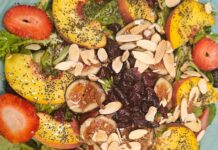 Photo by Heath Sharp.
Photo by Heath Sharp.
Soon enough, we will celebrate Thanksgiving with turkey and all the trimmings. If the thought of having to cook a turkey is enough to cause panic, take comfort in the fact that help is just a few paragraphs away.
Chef Geoffrey van Glabbeek, executive chef of the Restaurant at Gilcrease, offers help in all things turkey. A Tulsa native and 2003 graduate of the Culinary Institute of America in Hyde Park, N.Y., van Glabbeek shares his thoughts on Thanksgiving and the best ways to prepare, cook and carve the perfect bird, as well as what to do with all those leftovers.
“Thanksgiving is all about tradition,” he says.
That sentiment is at the heart of the way he prepares the turkey for the big feast and is the reason that he prefers simply roasting the bird above all other methods.
The first step is prepping the bird. Before anything else can be done, the innards must be removed. Save them for making gravy.
To ensure a moist, flavorful turkey, van Glabbeek suggests brining, or submerging the bird in salty water for the purpose of tenderizing. Although some brines consist of a combination of salt and sugar, van Glabbeek prefers using only kosher salt.
“Since kosher salt crystals are milder than iodized salt, it is easier to season without overseasoning,” he says. “The water should be salty like the ocean. A good rule of thumb is one cup of salt per gallon of water. Most turkeys will need two gallons to be completely submerged.”
Using a large bucket or other pot, dissolve salt in slightly warm water. Place the bird in the bucket and cover with a gallon of cold water until bird is completely submerged. Pack with ice and refrigerate for no more than 24 hours.
“Brining is good, but doing it for too long can actually break down the bird and make it tough.”
Although frying was a huge trend a few years ago, roasting is van Glabbeek’s preference because of both tradition and taste – roasting “low and slow” will produce the best result.
For starters, preheat the oven to 325 degrees. Place the turkey, breast side up, on a large sheet pan fitted with a cooling rack that will allow the juices to accumulate for making gravy later. Truss the turkey by tying its legs together and tucking the wings underneath.
Once the turkey is ready for the oven, van Glabbeek rubs the bird with herbed oil made by combining one cup of olive oil with one tablespoon each of fresh thyme, sage and minced garlic. Rub the bird liberally before roasting. Save some of the oil for basting the turkey occasionally.
Roast the turkey for 10-15 minutes per pound or until a probe thermometer inserted in the thickest part between the leg and thigh reaches 165 degrees. Let the turkey rest for 15-20 minutes before carving.
As far as stuffing the bird is concerned, van Glabbeek does not recommend it.
“By the time the stuffing is cooked through, the bird is overcooked. Cook the stuffing separately,” he suggests.
Carve the bird by first cutting off the legs and the wings. Next, cut down the middle of the bird until the knife reaches the ribcage. Follow the ribcage all the way down and remove the breast in one piece. Repeat the same procedure with the other breast.
“Use a straight blade like a chef’s knife for carving the turkey,” he advises.
As for leftovers, van Glabbeek suggests piling some of that turkey on a croissant with a slice of creamy brie, some peppery arugula and a slathering of whole grain mustard.
Alternatively, leftover turkey can be used in a delicious pasta sauce. Thinly slice one onion and sauté in olive oil over medium heat until caramelized. Add two cups of turkey meat and warm slightly. Deglaze pan with one half cup white wine and let reduce until almost all of the liquid is absorbed. Add one cup of chicken stock and two tablespoons butter. Bring to a simmer and add two handfuls of spinach. Cook until spinach is just barely wilted. Serve over ravioli.
























